Experimental investigation of omnidirectional multiphysics bilayer invisibility cloak with anisotropic geometry
Huolei Feng(丰火雷), Xingwei Zhang(张兴伟), Limin Zhou(周利敏),Yuekai Zhang(张悦凯), and Yushan Ni(倪玉山),†
1Department of Aeronautics and Astronautics,Fudan University,Shanghai 200433,China
2Key Laboratory of Advanced Ship Materials and Mechanics,College of Aerospace and Civil Engineering,Harbin Engineering University,Harbin 150001,China
Keywords: omni-directionality,multiphysics,bilayer confocal ellipse,invisibility cloak
1.Introduction
Inspired by the pioneering theoretical works of transformation optics[1]and neutral inclusion,[2-4]the devices, especially invisibility cloaks, have attracted extensive attention,and have been widely explored in many different single physical systems.[5-23]Stengeret al.fabricated a cloaking structure for elastic waves and observed good cloaking behavior for carrier frequencies.[6]Yanget al.presented the first experimental demonstration of a dc electric cloak for steady current fields.[8]Hanet al.designed an electromagnetic invisibility anti-cloak based on nonlinear coordinate transformation.[9]Liet al.discussed temperature-dependent switchable thermal cloaks using the temperature-dependent coordinate transformation thermotics.[20]These invisibility devices can prevent the external field from invading the inner core in the single physical field, thus achieving the cloaking effect without distorting the external physical field.With the further development of metamaterials,the multifunctional structures[24]have become a promising field of research, such as the mechanical multifunctional structure,[25]the intelligent multifunctional structure,[26,27]and the multiphysics structure.[28-30]Here, we mainly discuss the multiphysics structure to reveal the manipulation effects of the invisibility cloaks.The multiphysics invisibility cloaks constructed with neutral inclusion method have the capability to respond to multiphysics fields,simultaneously.Maet al.implemented a monolayer circular thermal-electric cloak to guide both electric current and heat flux around the core region.[31]Zhanget al.designed a bilayer circular thermal-electric cloak to improve the accuracy of cloaking effect.[32]Fenget al.analyzed the thermal-electric invisibility sensors and cloaks with anisotropic geometry under a specific direction of heat flux and electric current.[33]
The above researches reveal the multiphysics cloaking effect from different perspectives.But for a device with anisotropic geometry, the presented cloak is only suitable for unidirectional heat flux and electric current.Recently, some researchers discussed omnidirectional metadevices in different physical fields.Hanet al.constructed an omnidirectional thermal metadevice with anisotropic geometry to achieve excellent performance along arbitrary directions of heat flux.[34]Fenget al.presented the omnidirectional confocal elliptical monolayer thermal-electric camouflage device, which could eliminate the disturbances of isotherms and equipotential lines in the external environment.[35]However,the studies[34,35]still have limitations.The former[34]mainly discussed the omnidirectional effect in a single thermal field,lacking the responses to multiphysics profiles.The latter[35]only eliminated the disturbances of isotherms and equipotential lines in the matrix,and the temperature and electric potential gradients in the core still existed due to the limitation of the single layer of the device.Different from the research related to omnidirectional metadevices with anisotropic geometry mentioned above, we further extended from the confocal elliptical monolayer coreshell structure to the bilayer core-shell structure to investigate the omnidirectional thermal-electric cloaking function,which could improve the utilization efficiency of the invisibility cloak with anisotropic geometry and achieve the omnidirectional multiphysics cloaking effect.Due to the anisotropy of confocal ellipse, the depolarization factors of bilayer core-shell structure will be changed under different directions of heat flux and electric current,thus resulting in the anisotropic effective parameters of the bilayer core-shell structure.Here,the inner shell of the structure is selected as thermal-electric insulating material to prevent heat flux and electric current from invading the core region, and the matrix material parameters coincide with the derived anisotropic effective parameters to eliminate the disturbances of external multiphysics fields in the matrix.Then,finite element simulations are employed to demonstrate the performance of omnidirectional thermal-electric cloaking effect applying the anisotropic matrix material and insulated inner shell material.Meanwhile,we design a composite structure to realize the anisotropy of matrix, and experimentally validate full manipulation of heat flux and electric current in the invisibility cloak.When the external heat flux and electric current are in a specific direction, we further achieve the cloaking effect using the existing natural materials instead of the composite structure or the arbitrary isotropic parameters to enrich the range of materials selection.
2.Methodology
The realization of omnidirectional thermal-electric invisibility cloak with anisotropic geometry needs to consider the material parameters in temperature and electric potential fields simultaneously.The schematic diagram of confocal elliptical bilayer core-shell structure is shown in Fig.1.Regions I,II,III and IV represent the core,inner shell,outer shell,and matrix,respectively.In order to study the characteristics of temperature field and electric potential field in different regions, we useTiandφi(i=1,2,3,m)to represent the temperature and electric potential of the core, inner shell, outer shell and matrix, respectively, and the corresponding thermal and electric conductivities are denoted asκiandσi.The semi-axes of the core,inner shell,and outer shell are denoted aslci,lsi,andlei(i=1,2),respectively.
As for the derivation of effective parameters (effective thermal conductivity and effective electric conductivity) of confocal elliptical bilayer core-shell structure,we first present the effective parameters derivation of the core and inner shell based on the theory of neutral inclusion.[35]Then, we regard the core and inner shell as a new core,and calculate the effective parameters of the new core and outer shell.
In order to solve the effective parameters more conveniently, we discuss the case in elliptical coordinates.The elliptical coordinates can be expressed as
Whenρ=0, Eq.(1)denotes the confocal elliptical core surface with semi-axislci.Whenρ >0, we definelias the semi-axis of the ellipse, andl2i=lc2i+ρ.Accordingly, the Cartesian coordinates can be expressed as
Considering the confocal elliptical monolayer core-shell structure presented in a uniform thermal(or electric potential)gradient field along thexdirection without heat (or electric)source, the heat conduction equation (or electric conduction equation)satisfies the Laplace equation.In order to unify the derivation process,we useKi(i=1,2,m)to represent the temperatureTior electric potentialφiin different regions, which can be expressed as[36]
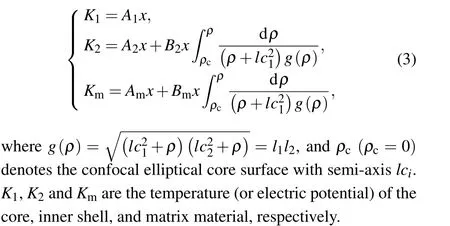
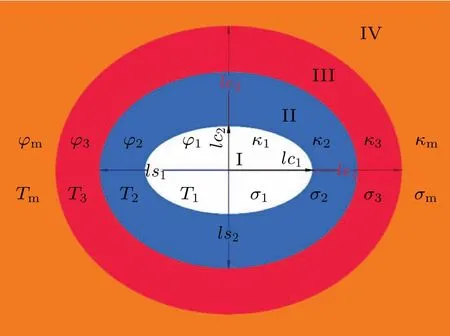
Fig.1.The schematic diagram of confocal elliptical bilayer core-shell structure.
Meanwhile,different regions possess different conductivitiesMi(M=κrepresents the thermal conductivity andM=σrepresents the electric conductivity).Based on the above discussions,the associated boundary conditions are as follows.
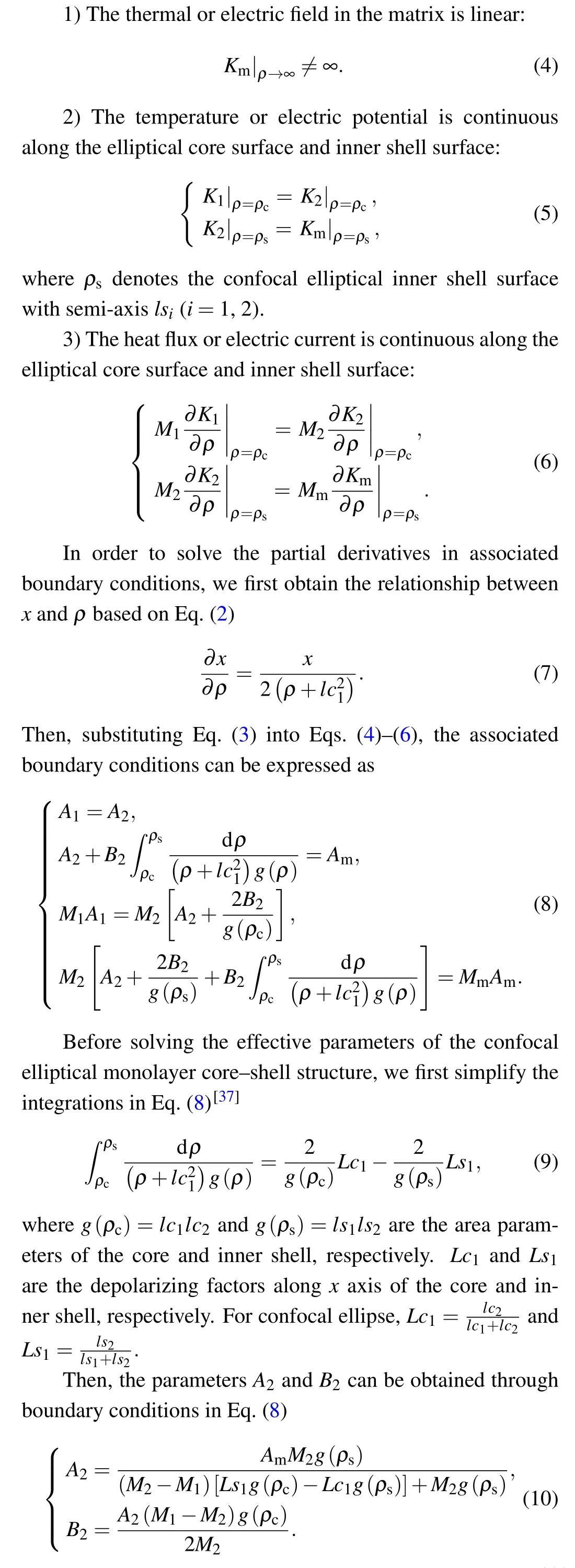
Taking Eq.(10) into the fourth boundary condition of Eq.(8),we can get the effective parametersM*1of the monolayer core-shell structure

So far, we have deduced the effective parameters of the confocal elliptical monolayer core-shell structure.By regarding the monolayer core-shell structure as a new core which possesses the effective parametersM*1, the new effective parametersM*2of the confocal elliptical bilayer core-shell structure can be calculated as follows:
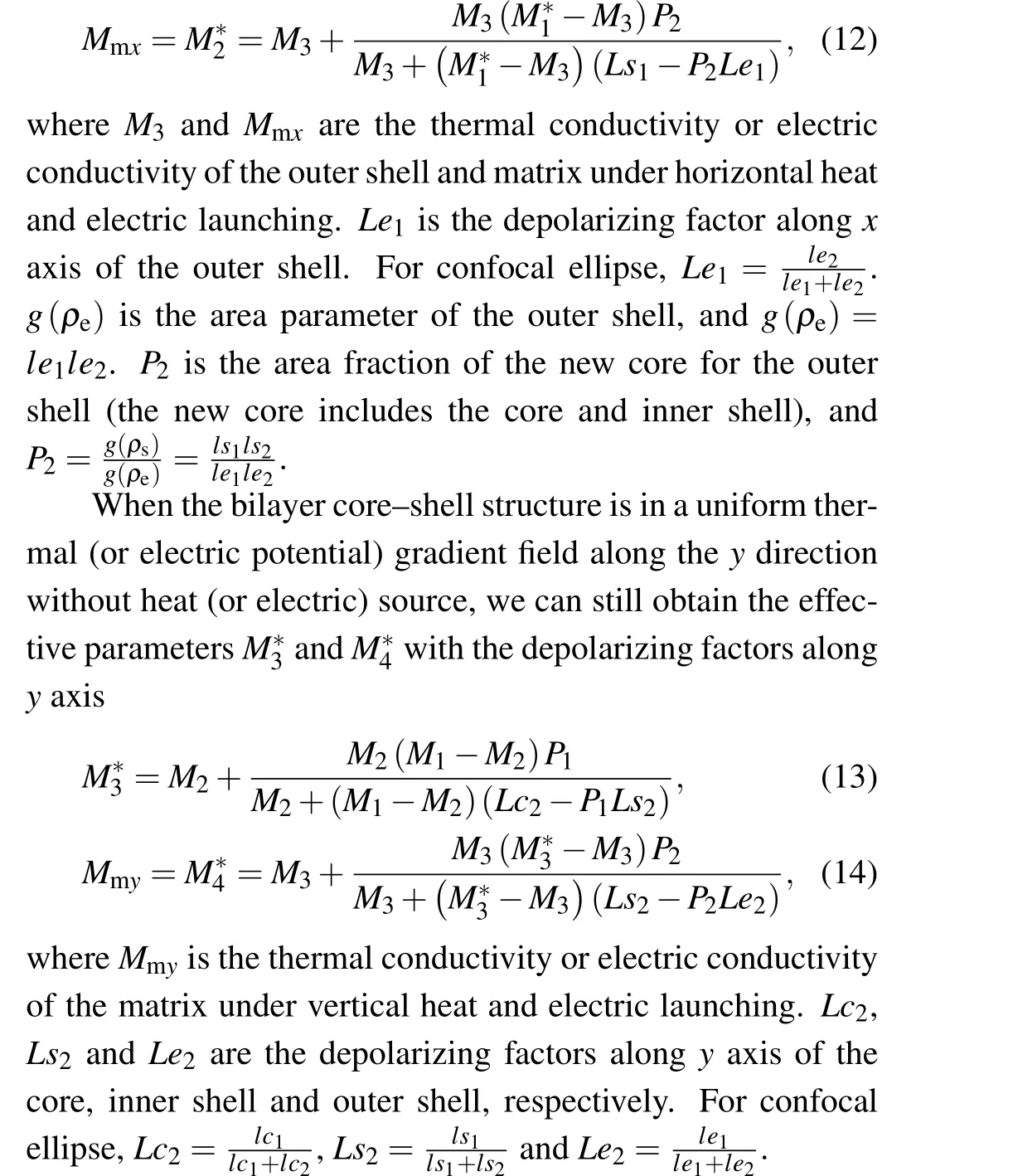
To sum up, the effective parameters of the confocal elliptical bilayer core-shell structure along different axes can be obtained by solving Eqs.(11)-(14)simultaneously.In Subsection 3.1, we will discuss the omnidirectional thermal-electric cloaking effect by applying the derived effective parameters.
3.Results and discussion
3.1.The omnidirectional thermal-electric cloaking effect with anisotropic matrix
Due to the geometric anisotropy of the confocal elliptical bilayer core-shell structure,the effective parameters(thermal and electric conductivities) will be changed as the heat flux and electric current flow along different axes, which leads to the anisotropy of the matrix material.As for the realization of omnidirectional thermal-electric invisibility cloak, the materials of the inner shell and outer shell are selected as polydimethylsiloxane (PDMS) and 6061 aluminum, respectively.The material of the core (cloaking region) is arbitrary, such as 316/436 stainless steel, copper, tungsten and so on.Here,we select copper as the core material.The relevant material parameters are shown in Table 1.When the geometric parameters of the core,inner shell and outer shell are given,the anisotropic material parameters of the matrix can be calculated based on Eqs.(11)-(14) to achieve the omnidirectional thermal-electric cloaking effect.
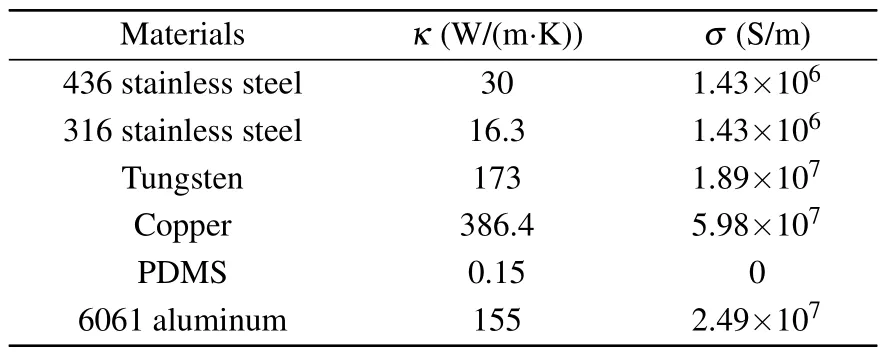
Table 1.The parameters of these selected materials.
We use the finite element method to simulate the omnidirectional thermal-electric cloaking effect of the confocal elliptical bilayer core-shell structure under different directions(α=0°, 45°, and 90°) of heat flux and electric current.The simulation results are shown in Figs.2 and 3,in which the field distributions are normalized by the maximum values.
From Fig.2,we firstly focus on the first row corresponding to horizontal direction of heat flux.The normalized temperature field of the matrix is illustrated in Fig.2(a1),and the isothermal lines in the matrix are uniformly distributed without any disturbances.When the core is embedded in the matrix, the isothermal lines appear disturbances, especially near the core,and the heat flux also passes through the core region,as shown in Fig.2(a2).Then,we coat the core with the bilayer thermal-electric cloak illustrated in Fig.2(a3),and the isothermal lines tend to be straight again, just as the core doesn’t exist.The cloak also prevents the heat flux from invading the core region successfully.It is clearly seen that the core with elliptical cloak performs as perfectly as the matrix without any distortions,showing much better performance compared to the bare core.Meanwhile, the perfect thermal cloaking effect is realized to make the temperature of core tend to be a constant.In order to realize the omnidirectional thermal cloaking effect,we change the directions of heat flux to the oblique and vertical directions,and the simulation results are shown in Figs.2(b1)-2(b3) and 2(c1)-2(c3).The disturbances of isothermal lines in the matrix and the temperature gradients in the core illustrated in Figs.2(b2)and 2(c2)have been eliminated under the work of the thermal-electric cloak, as shown in Figs.2(b3)and 2(c3).It means that the omnidirectional thermal cloaking effect has been demonstrated without any disturbances of isothermal lines.
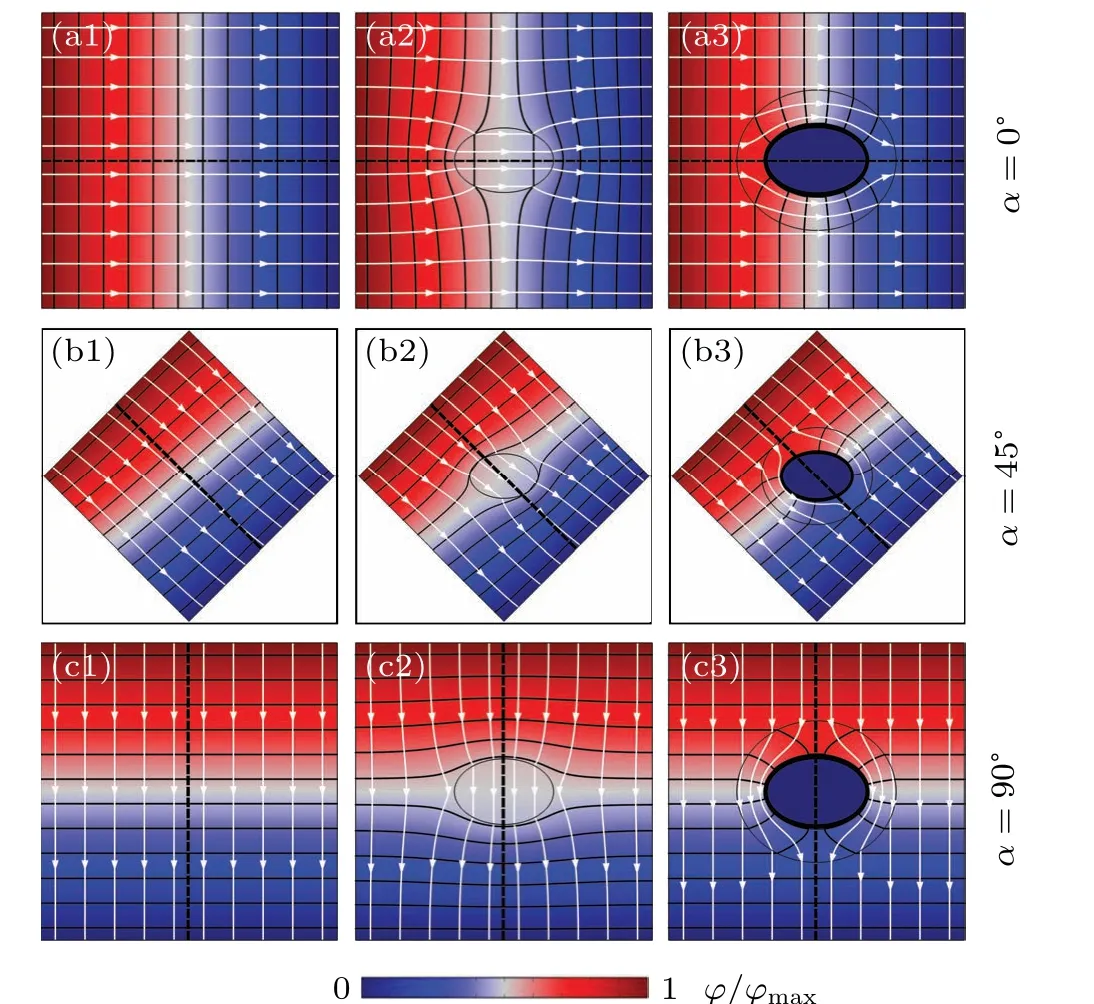
Fig.3.Normalized electric potential distributions with different directions of electric current.The first, second, and third rows correspond to the horizontal (α =0°), oblique (α =45°), and vertical (α =90°)electric current launching, respectively.The first, second, and third columns represent the normalized electric potential fields of models with anisotropic matrix material, bare core without confocal elliptical invisibility cloak, and bare core with confocal elliptical cloak, respectively.The black solid lines represent the equipotential lines, and the white streamlines represent the electric current.
The thermal-electric cloak can realize not only the omnidirectional thermal cloaking effect but also the omnidirectional electric cloaking effect.No matter how the direction of external electric current changes, the disturbances of equipotential lines in the matrix caused by the core [Figs.3(a2),3(b2), and 3(c2)] have been eliminated when the core is protected by the thermal-electric cloak [Figs.3(a3), 3(b3), and 3(c3)].In addition,due to the thermal-electric insulation properties of the inner shell, the electric current will bypass the core region,thus making the electric potential gradient of the core approach 0.Here, considering that the material of the core is arbitrary,we further select 316 stainless steel and tungsten as the core material to demonstrate the omnidirectional thermal-electric cloaking effect.The material parameters of the 316 stainless steel and tungsten are presented in Table 1,and the boundary conditions remain unchanged.Similar to the cloaking effects in Figs.2 and 3, the perfect omnidirectional thermal-electric cloaking effects are also achieved whether the core is constructed with 316 stainless steel or tungsten, thus demonstrating the arbitrariness in core material selection.The corresponding temperature and electric potential profiles with the core made of 316 stainless steel or tungsten are presented in the supplementary material (Figs.S1-S4).As mentioned above, we have demonstrated the omnidirectional accurate thermal-electric cloaking effect of the confocal elliptical bilayer core-shell structure, which indicates the rationality of the theoretical derivation presented in the methodology section.

Fig.4.The normalized temperature or electric potential along the dashed lines.The first,second,and third rows correspond to the horizontal(α =0°),oblique(α =45°),and vertical(α =90°)directions of heat flux and electric current,respectively.The first column and the second column represent the normalized temperature fields and electric potential fields of three different models, respectively.Model-1, model-2 and model-3 represent the temperature and electric potential fields of anisotropic matrix material,the bare core without thermal-electric cloak device,and the core with thermal-electric cloak device,respectively.

Table 2.The normalized temperature and electric potential gradients of the core and matrix under different heat and electric launching.
In order to further quantitatively analyze the omnidirectional thermal-electric cloaking effect, we export the normalized temperature and electric potential on the dashed lines in Figs.2 and 3.The results corresponding to different directions of heat flux and electric current are presented in Fig.4.Meanwhile,the normalized temperature gradients(TG)and electric potential gradients(EPG)of the core and matrix under different heat and electric launching are shown in Table 2.
From Fig.4,the normalized temperature and electric potential of model-1 and model-3 are consistent in the matrix,which are different from those of model-2, whether the directions of heat flux and electric current are 0°, 45°, or 90°.The temperature and electric potential gradients of model-1 and model-3 in the matrix are 5.56 (1/m), which is different from the value of model-2 [see Table 2].It means that the existence of thermal-electric cloak could eliminate disturbances of model-2 in the matrix, thus achieving omnidirectional thermal-electric cloaking effect of the core.Simultaneously,compared with the normalized temperature and electric potential of model-1 and model-2 in the core, the corresponding values of model-3 tend to be the constant 0.5 and 0, respectively.The temperature and electric potential gradients of model-3 in the core tend to be 0 with different directions of heat flux and electric current [see Table 2], indicating that the core is omnidirectionally protected from the invasion of external heat flux and electric current without disturbing the isothermal and equipotential lines in the matrix.We have quantitatively revealed the omnidirectional thermalelectric cloaking effect with derived anisotropic material parameters, thus demonstrating the feasibility of the proposed theoretical method to construct the device.
3.2.The bilayer thermal-electric invisibility cloak suitable for a wide range of natural materials
Subsection 3.1 mainly focuses on how to eliminate the disturbances of thermal and electric potential fields caused by geometric anisotropy when the directions of heat flux and electric current are unknown, thus achieving omnidirectional thermal-electric cloaking effect.The proposed method is to design anisotropic matrix.In this part, we further discuss the condition that the heat flux and electric current are in a specific direction, and design a bilayer thermal-electric invisibility cloak.Different from the omnidirectional thermal-electric cloak with anisotropic matrix or the thermal-electric cloak with arbitrary isotropic parameters,we use the existing natural bulk materials to design the directional cloak.Here,we choosex-axis as the specific direction of heat flux and electric current.The materials selection of the core, inner shell, outer shell,and matrix are copper,PDMS,6061 aluminum,and 316 stainless steel, respectively.The relevant material parameters are shown in Table 1.When the geometric parameters of the core are given(lc1=3 cm,lc2=2 cm),the geometric parameters of the inner shell and outer shell can be calculated based on the Eqs.(11)and(12)accurately.Compared with the omnidirectional thermal-electric cloak achieved with anisotropic matrix, we could use the isotropic natural materials to construct the bilayer thermal-electric cloak to realize accurate cloaking effect under the specific direction of heat flux and electric current.The normalized simulation results of the temperature and electric potential profiles are shown in Fig.5.
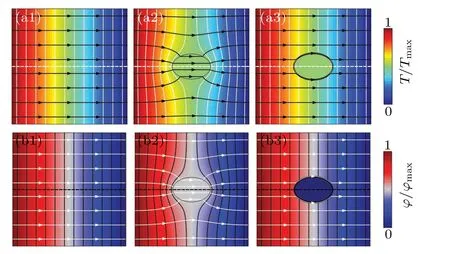
Fig.5.Normalized temperature and electric potential profiles under the specific direction of heat flux and electric current.The first row represents the normalized temperature profiles.The second row represents the normalized electric potential profiles.Panels (a1) and (b1) correspond to the matrix structure.Panels (a2) and (b2) correspond to the bare core structure.Panels(a3)and(b3)correspond to the bilayer cloak structure.The white solid lines represent the isothermal lines, and the black solid lines represent the equipotential lines.The black streamlines represent the heat flux, and the white streamlines represent the electric current.
It can be seen in Fig.5 that compared with the bare core structure illustrated in Figs.5(a2) and 5(b2), the heat flux and electric current in Figs.5(a3)and 5(b3)travel around the core without disturbing the isothermal lines and equipotential lines in the matrix, which coincide with the temperature and electric potential profiles of the matrix structure illustrated in Figs.5(a1) and 5(b1), thus realizing the perfect thermal and electric cloaking effect using the isotropic natural materials.These natural materials satisfying the concept of neutral inclusion are arbitrary,which can also broaden the selection range of materials.Similar to Fig.4, we further export the normalized temperature and electric potential on the dashed lines in Fig.5.The results corresponding to horizontal direction of heat flux and electric current are presented in Fig.6.
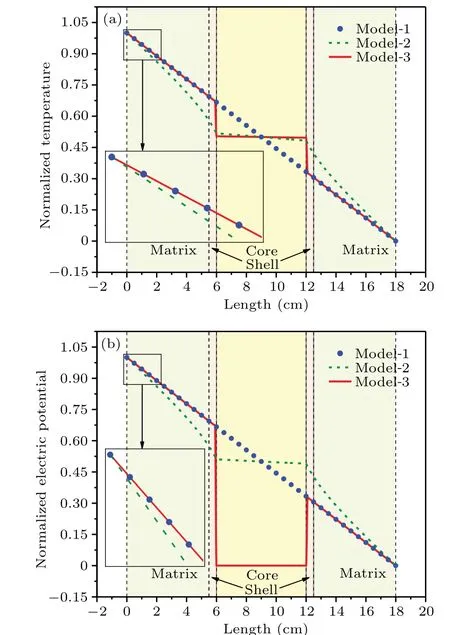
Fig.6.The normalized temperature(a)or normalized electric potential(b)along the dashed lines.Model-1,model-2 and model-3 represent the three different models illustrated in the first,second,and third columns of Fig.5,respectively.
The normalized temperature and electric potential of model-3 and model-1 match perfectly in the matrix, while the values of model-2 are completely different from those of model-1.It reveals that the thermal-electric cloak in model-3 could eliminate disturbances caused by the elliptical core in the matrix,thus making the normalized temperature and electric potential distributions in the matrix consistent with those in model-1,just as there is no object in the matrix.In addition to not disturbing the temperature and electric potential fields in the matrix,the thermal-electric cloak in model-3 could also prevent the heat flux and electric current from invading the core region,which makes the temperature and electric potential gradients in the core tend to be 0.Due to the high thermal and electric conductivities of the core material (copper)compared with the other materials placed in the shell and matrix regions,the isotherms and equipotential lines will bypass the core region,which makes the normalized temperature and electric potential of model-2 in the core tend to be constants.If the thermal and electric conductivities of the core are smaller than those of other regions, this phenomenon will disappear.Through the above analyses, the data in Fig.6 echoes the simulation result in Fig.5 perfectly, thus demonstrating thex-directional thermal-electric cloaking effect of the confocal elliptical cloak implemented with existing natural bulk materials.The existing natural materials greatly widen the material selection range and practical application field of the directional cloak.The directional cloak may have potential applications to provide protection for some electronic components,especially in the thermal-electric fields.
3.3.Experimental investigation of omnidirectional multiphysics bilayer invisibility cloak
After the above simulation analyses,we next experimentally realize the omnidirectional thermal-electric invisibility cloaks.We construct a new kind of composite structure to replace the anisotropic matrix material, and the specific construction process is illustrated in Fig.7.
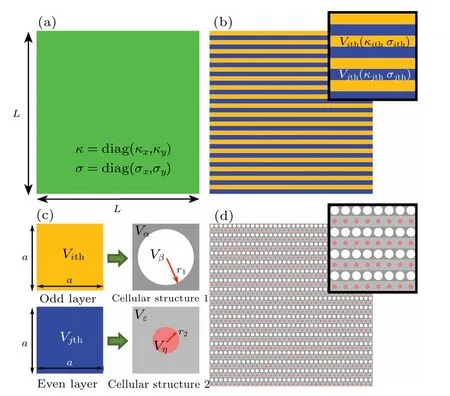
Fig.7.Processing approach of constructing anisotropic matrix.
The matrix (L×L) with anisotropic thermal and electric conductivities [Fig.7(a)] is first transformed into alternating multilayered structure based on the effective medium theory.The alternating multilayered structure possesses isotropic but arbitrary material parameters for each layer[Fig.7(b)].Then,as for each layer of the arbitrary material parameters, we design the cellular structure composed of substrate and inclusion with natural materials [Fig.7(c)] to satisfy the arbitrary thermal and electric conductivities, simultaneously.Inclusions in odd and even layers have different geometric parameters.The thermal and electric conductivities of the cellular structures in different layers can be obtained as follows:
whereVith(i=1,3,5,...) andVjth(j=2,4,6,...) are the arbitrary thermal or electric conductivities of odd layer and even layer,respectively.Vα,Vβ,Vε,andVηare the thermal or electric conductivities of different natural materials, respectively.f1=πr21/a2andf2=πr22/a2are the area fractions of the circular inclusions in different cellular structures.r1andr2are the radii of the circular inclusions of odd and even layers,respectively.ais the thickness of each layer.
When the thickness of each layer and the different natural material parameters satisfying the concept of neutral inclusion are given, the radii of the circular inclusions in odd and even layers could be calculated based on Eqs.(15) and (16).Through the array of the cellular structures, we could obtain a composite structure [Fig.7(d)], which possesses the same anisotropic material parameters as the matrix[Fig.7(a)].
Then, we start preparing the experimental samples.The first step is to determine the geometric and material parameters of the invisibility cloak (functional sample).The major(or minor) semi-axes of the core, inner shell, and outer shell arelc1= 3 cm (lc2= 2 cm),ls1= 3.2 cm (ls2= 2.3 cm),andle1=4.85 cm (le2=4.3 cm), respectively.The materials of the core,inner shell and outer shell are 6061 aluminum,PDMS, and 6061 aluminum, respectively.Here, it should be noted that the material of core is selected as 6061 aluminum to eliminate the resistance at the connection interface of different materials and carry out the experiments smoothly.For the required matrix material calculated by Eqs.(11)-(14),we implement the anisotropic matrix material with composite alternating multilayered structure mentioned above.Each of the layers is designed by the periodic structure of an air circular inclusion embedded in the middle of the 6061 aluminum substrate.The thickness of each layer is 0.5 cm, and the radii of the air circular inclusions in different cellular structures are 0.1 cm and 0.21 cm for the alternating layers, respectively.The second step is to draw the sketches of the invisibility cloak according to the geometric parameters in the first step.The last step is to purchase the required experimental materials and construct the experimental samples by laser cutting and material splicing technologies.Based on the three steps mentioned above, the invisibility cloak could be constructed, as shown in Fig.8(a).For comparison, we have also fabricated the reference structure,in which the bare core with 6061 aluminum is embedded in the middle of the matrix without the thermal-electric cloak,as shown in Fig.8(b).
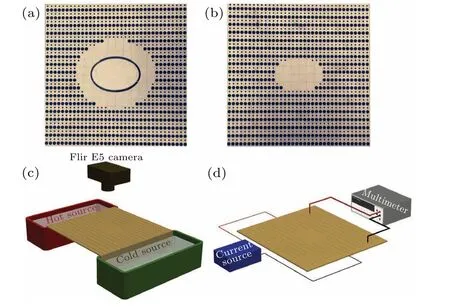
Fig.8.The experimental samples and setups.Experimental samples whose sizes are 18×18 cm with a thickness of 2 mm of the invisibility cloak (a) and reference structure (b).(c) The diagram of thermal experimental setup.(d)The diagram of electric experimental setup.
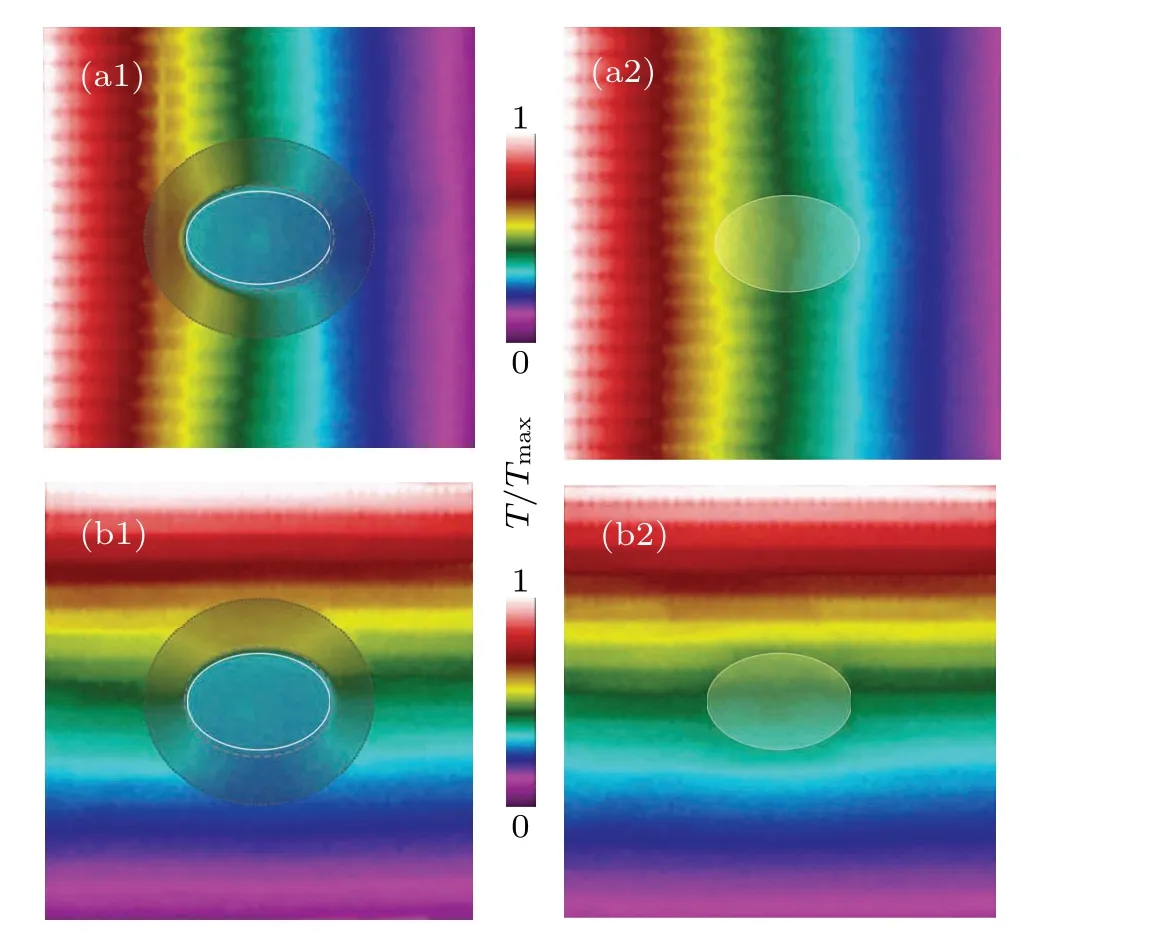
Fig.9.Measured normalized temperature profiles for invisibility cloak and reference structure.Panels(a1)and(a2)correspond to the horizontal heat flux launching.Panels(b1)and(b2)correspond to the vertical heat flux launching.
Considering the operability of the experiments, we mainly focus on the 0°and 90°directions of heat flux and electric current.The diagrams of thermal and electric experimental setups are shown in Figs.8(c) and 8(d).In the thermal experimental setup,we first put the insulated plastic films(PDMS)on the surface of the invisibility cloak and reference structure to eliminate the high reflection by 6061 aluminum and thermal convection by air.Then,a tank filled with hot water is employed to provide heat source,while the cold source is achieved with the mixture of ice and water.After the temperature stabilizes,we use the Flir E5 infrared camera to obtain the temperature profiles of these samples, and the obtained data will be imported into FLIR Tools for post processing analyses.As for the electric experimental setup,we first need to draw a regular grid on the invisibility cloak and reference structure for the measurement of electric potential later.Then, a powerful DC current source device is connected to all experimental samples by introducing wire clips at the two ends of these samples to make the current pass through the cloak and reference structure, thus generating electric potential.After the electric potential stabilizes, we use the high-precision digital multimeter 34401A to measure the electric potential profiles at the painted grid nodes of these samples,and record the data at each node.Here,both the temperature data and electric potential data are normalized within 0 and 1 to better compare and present the differences of omnidirectional multiphysics cloaking effect between the functional cloak and reference structure.
The measured temperature and electric potential profiles normalized by the maximum values are shown in Figs.9 and 10.
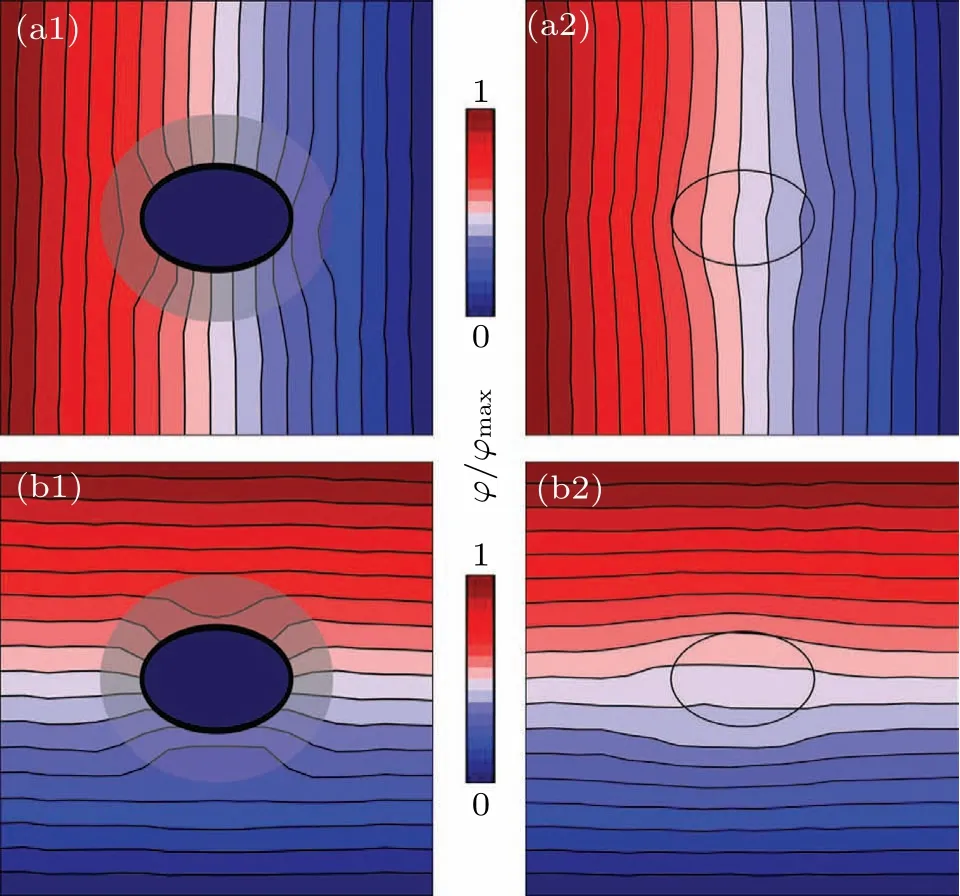
Fig.10.Measured normalized electric potential profiles for invisibility cloak and reference structure.Panels (a1) and (a2) correspond to the horizontal electric current launching.Panels (b1) and (b2) correspond to the vertical electric current launching.
Figures 9(a1),9(b1)and 10(a1),10(b1)represent the temperature and electric potential experimental measurements of the core with thermal-electric invisibility cloak, respectively.Figures 9(a2),9(b2)and 10(a2),10(b2)represent the temperature and electric potential experimental measurements of the reference structure(bare core without thermal-electric cloak),respectively.We can see that the cloak [Figs.9(a1), 9(b1),10(a1), 10(b1)] successfully fulfills its task in that the temperature and electric potential gradients of the core tend to be 0, and the disturbances of isothermal and equipotential lines are eliminated in the matrix under the horizontal and vertical directions of heat flux and electric current.In contrast, the bare core in the reference structure[Figs.9(a2),9(b2),10(a2),10(b2)] alters the temperature and electric potential profiles in the matrix, especially near the core region, and the omnidirectional cloaking effect of the core also disappears.The corresponding simulation results of temperature and electric potential profiles are presented in the supplementary material(Figs.S5 and S6), which are in good agreement with the experimental results (Figs.9 and 10).Based on the above experimental analyses, the proposed thermal-electric invisibility cloak is capable of shielding the external heat flux and electric current omnidirectionally without distorting the temperature and electric potential fields in the matrix, thus successfully achieving the construction of the omnidirectional thermal-electric bilayer invisibility cloak with anisotropic geometry.The omnidirectional thermal-electric cloaking effect makes the proposed invisibility cloak suitable for more complex and changeable environments,which may have potential applications in the aerospace field to protect some important devices,such as the radars,aircraft,and military installations.
4.Conclusions
The omnidirectional thermal-electric cloaking effect of the structure with anisotropic geometry is discussed in this paper.We first derive the anisotropic effective thermal and electric conductivities of confocal elliptical bilayer core-shell structure based on the different depolarization factors along different axes.Then,the matrix material should be anisotropic as the effective parameters, and the inner shell should be selected as thermal-electric insulating material to satisfy omnidirectional thermal-electric cloaking effect, which is demonstrated by the numerical simulations.The experiments using the composite structure to replace the anisotropic matrix have been also carried out to realize the omnidirectional cloaking effect,which are in good agreement with the simulation results combining the derived anisotropic material parameters.When the directions of heat flux and electric current are known, we achieve thex-directional thermal-electric cloaking effect using the isotropic natural materials, which could widen the range of materials selection for constructing the invisibility cloak.Whether it is omnidirectional orx-directional thermalelectric cloak, the proposed schemes are implemented with existing composite or natural materials, thus indicating that our schemes may have potential applications in multiphysics fields.The omnidirectional cloak is suitable for both temperature and electric potential fields,which contributes to realizing the efficient utilization of the cloaking device and may have positive impacts on carbon neutrality and carbon peaking.
Acknowledgements
This work was financially supported by the National Natural Science Foundation of China (Grant No.11572090) and the Fundamental Research Funds for the Central Universities(Grant No.3072022GIP0202).
- Chinese Physics B的其它文章
- A multilayer network diffusion-based model for reviewer recommendation
- Speed limit effect during lane change in a two-lane lattice model under V2X environment
- Dynamics of information diffusion and disease transmission in time-varying multiplex networks with asymmetric activity levels
- Modeling the performance of perovskite solar cells with inserting porous insulating alumina nanoplates
- Logical stochastic resonance in a cross-bifurcation non-smooth system
- Exploration of the coupled lattice Boltzmann model based on a multiphase field model: A study of the solid–liquid–gas interaction mechanism in the solidification process

